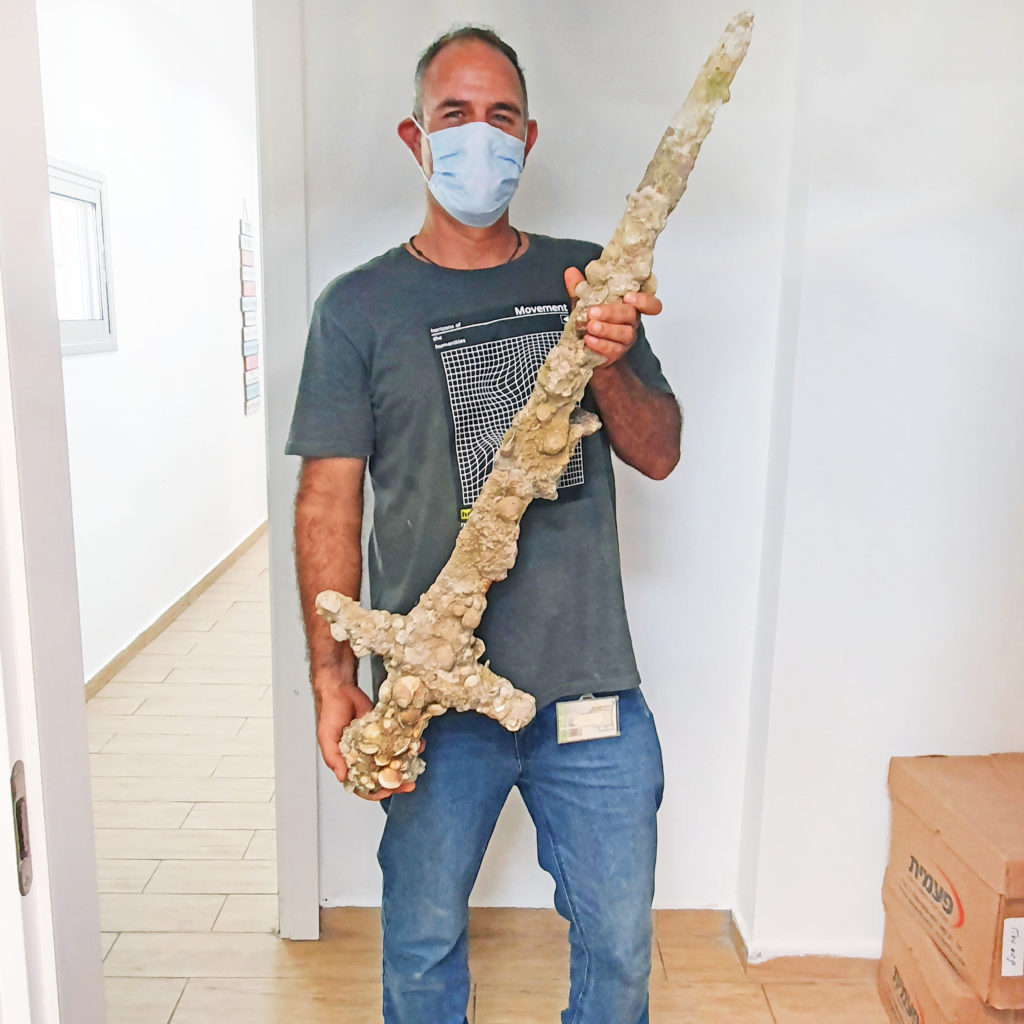
Shlomi Katzin, a resident of the Israeli city of Atlit, was scuba diving off the Carmel Coast last Saturday, when his dive turned into a very unexpected discovery: a 900-year-old Crusader sword. Katzin saw the ancient weapon on the seabed amidst other archaeological artifacts—such as stone and metal anchors and pottery fragments—and knew what he had to do to rescue the items from being buried and lost beneath the sand. Like a modern King Arthur, he took the sword from the water, and then like a good citizen, he contacted the Israel Antiquities Authority (IAA). In return, the IAA gave him a certificate of appreciation for good citizenship.
“The sword, which has been preserved in perfect condition, is a beautiful and rare find and evidently belonged to a Crusader knight,” Nir Distelfeld, inspector for the Israel Antiquities Authority’s Robbery Prevention Unit, said in an IAA press release about the discovery. “It was found encrusted with marine organisms, but is apparently made of iron. It is exciting to encounter such a personal object, taking you 900 years back in time to a different era, with knights, armor and swords.”
The archaeological site itself had actually been discovered in June and was being monitored by the IAA, but the press release noted the shifting sands in the sea make the artifacts “very elusive.” That’s a general problem for ancient discoveries in the ocean.
“Underwater surveying is dynamic,” Director of the IAA’s Marine Archaeology Unit Kobi Sharvit said in the press release. “Even the smallest storm moves the sand and reveals areas on the seabed, meanwhile burying others. It is therefore vitally important to report any such finds and we always try to document them in situ [in the original location], in order to retrieve as much archaeological data as possible.”
Regarding the crusader sword site, Sharvit said the archaeological discoveries “show that it served as a small, temporary natural anchorage for ships seeking shelter. Identification of the various finds shows that the anchorage was used in as early as the Late Bronze Age, 4,000 years ago. The recent discovery of the sword suggests that the natural cove was also used in the Crusader period, some 900 years ago.”
Ironically, it is a modern form of entertainment like scuba diving that is helping to find these old world artifacts. “The discovery of ancient finds by swimmers and leisure divers is a growing phenomenon in recent years, with the increasing popularity of such sports,” said Sharvit.
The press release said that IAA Director General Director Eli Escosido “praised” Katzin for bringing the find to the IAA, noting that after the three-foot-long (one-meter-long) bladed sword has been cleaned and researched by the IAA, they “will ensure it is displayed to the public.”
Said Escosido, “Every ancient artifact that is found helps us piece together the historical puzzle of the Land of Israel.”
Indeed, between past discoveries and the new one, Sharvit was already analyzing what the discovery said about the region where the sword was found. “The Carmel coast contains many natural coves that provided shelter for ancient ships in a storm, and larger coves around which entire settlements and ancient port cities developed, such as Dor and Atlit,” said Sharvit. “These conditions have attracted merchant ships down the ages, leaving behind rich archaeological finds. The recently recovered sword is just one such find.”
And in a sense, it’s fitting that a Crusader sword was found by a resident of Atlit—which was once a Crusader outpost itself—even if that accidental archaeologist was doing something as modern as scuba diving.
(By Joshua Spurlock, www.themideastupdate.com, October 18, 2021)
